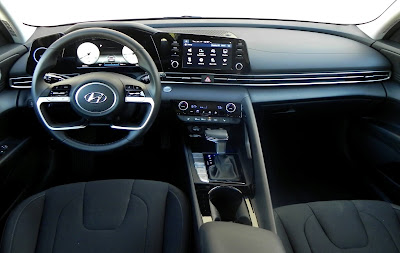LETS HAVE SOME RESPECT FOR NEW GENERATION HYUNDAI ELANTRA SEDAN
There was a time when the Hyundai Elantra was like the Rodney Dangerfield of compact cars. To paraphrase the classic comedian, it didn't get no respect.
But you can’t say even that about the Elantra any more. Though annual Detroit Auto Show has been canceled for this year after previously being moved from its traditional January dates, that didn’t keep a panel of judges from choosing the 2021 Hyundai Elantra for its 2021 North American Car of the Year award earlier this January.
It is the second time the Elantra has been so honored with the first coming in 2012.
Slightly longer and wider than its predecessor and with a sleeker profile, the seventh generation Elantra has been redesigned for 2021 and comes in three main trims not including the Elantra Hybrid and performance-oriented Elantra N and Elantra N Line models.
The SE is the base model that carries a starting MSRP of under $20,000 (not including destination and delivery) followed by the SEL and Limited trims that tack on added features as standard.
This review is based on the mid-portfolio SEL that carries a starting MSRP of $20,900. The top of the line Limited starts at $28,100. The Eco model of the past has joined the Elantra Hatchback on the sidelines for this year, but there is an Elantra Hybrid for the fuel conscious.
The drivetrain on SE, SEL and Limited models is a 2.0-liter 4-cylinder engine rated at 147 horsepower and 132 pound-feet of torque and mated to a continuously variable transmission that Hyundai calls an Intelligent Variable Transmission. (I have variable intelligence sometimes!). It comes with Normal, Sport, and Smart settings.
Resulting mileage figures are a solid 31 miles-per-gallon city, 41 highway, 35 combined. N-Line trims get a 1,6-liter turbo-4 with the either a 6-speed manual or 7-speed double clutch automatic.
Standard on the SEL are such features as blind-spot and rear cross-traffic alerts, driver-attention warning, forApple CarPlay and Android Auto, forward collision avoidance with pedestrian detection, lane-keeping assist, proximity key with push-button start, dual automatic temperature control, an 8-inch high-definition touchscreen, hands-free trunk release, rearview camera with dynamic guidelines, Bluetooth hands-free phone system, steering-wheel with cruise and audio controls, and a 6-speaker audio system.
A Convenience Packages for another $950 adds an enhanced collision mitigation system, adaptive cruise control, heated front seats, a leather-wrapped steering wheel and shifter, an electronic parking brake,, and wireless charging pad.
A Premium Package for $2,100 includes 17-inch alloy wheels in place of the standard 16-inchers, a power sunroof, Bose premium sound system, power adjustable driver’s seat with lumbar support, and dark chrome exterior accents.
Add in $156 for carpeted floor mats and the $995 destination charge and the total for my test Elantra came to $25,100.
With a comfortable ride and competitive pricing, the Elantra gives those who have not succumbed to the lure of the crossover SUV alternative to the offerings from Hyundai’s Japanese competitors.
“While some manufacturers no longer see the value in the car side of the business, we’re doubling down by offering an all-new model with both gas and hybrid powertrains,” José Muñoz, president and CEO, Hyundai Motor America, is quoted in a news release. “We’ve sold more than 3.4 million Elantras here in the U.S. and more than 13.8 million worldwide, and the new, captivating look is going to bring excitement to a whole new generation of buyers.”
Also coming with that is more respect as well.
What I liked about the 2021 Hyundai Elantra SEL: The cabin is very comfortable and roomy. Infotainment functions are very user-friendly — there’s even a knob to surf the radio dial — and there are lots of them. Exterior styling is very appealing, a result of Hyundai’s Sensuous Sportiness design identity approach.
What I didn’t like about the 2021 Hyundai Elantra SEL: As I have noted many times, I’m not a big fan of CVTs. There are simulated shift points you can select via the gear shifter on the console. (You can get a manual or double-clutch automatic by stepping up to the Limited or N Line models.) The emphasis with the Elantra is on fuel economy, not performance, though Sport mode does liven things up a bit.
Would I buy the 2021 Hyundai Elantra SEL? Yes. The Elantra is clear evidence that a compact fuel-sipper doesn’t have to settle for lackluster styling or a lack of convenience features and modern technological features.











































